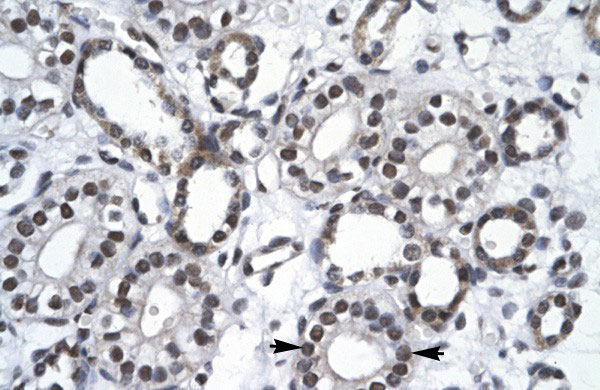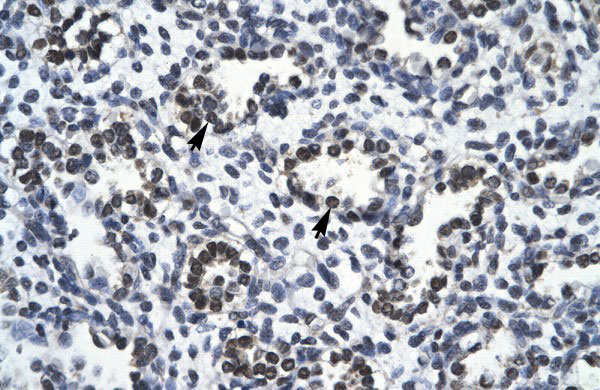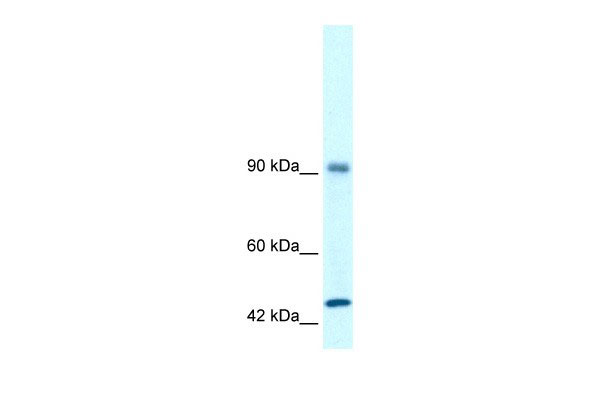RBM10 antibody - N-terminal region
Rabbit Polyclonal Antibody
- SPECIFICATION
- CITATIONS
- PROTOCOLS
- BACKGROUND

Application
| WB, IHC |
|---|---|
| Primary Accession | P98175 |
| Other Accession | P98175, NP_005667, NM_005676 |
| Reactivity | Human, Mouse, Rat, Rabbit, Dog, Guinea Pig, Horse, Bovine |
| Predicted | Human, Mouse, Rat, Rabbit, Pig, Dog, Guinea Pig, Horse, Bovine |
| Host | Rabbit |
| Clonality | Polyclonal |
| Calculated MW | 104 kDa |
| Gene ID | 8241 |
|---|---|
| Alias Symbol | S1-1, TARPS, GPATC9, ZRANB5, GPATCH9, DXS8237E |
| Other Names | RNA-binding protein 10, G patch domain-containing protein 9, RNA-binding motif protein 10, RNA-binding protein S1-1, S1-1, RBM10, DXS8237E, GPATC9, GPATCH9, KIAA0122 |
| Target/Specificity | RBM10 contains RNA recognition motif found in a variety of RNA binding proteins, including various hnRNP proteins, proteins implicated in regulation of alternative splicing, and protein components of snRNPs. In vitro studies showed that the rat homolog bound to RNA homopolymers, with a preference for G and U polyribonucleotides. This gene is part of a gene cluster on chromosome Xp11.23, and its 3' end lies within 20 kb upstream of UBE1. |
| Format | Liquid. Purified antibody supplied in 1x PBS buffer with 0.09% (w/v) sodium azide and 2% sucrose. |
| Reconstitution & Storage | Add 100 ul of distilled water. Final anti-RBM10 antibody concentration is 1 mg/ml in PBS buffer with 2% sucrose. For longer periods of storage, store at -20°C. Avoid repeat freeze-thaw cycles. |
| Precautions | RBM10 antibody - N-terminal region is for research use only and not for use in diagnostic or therapeutic procedures. |
| Name | RBM10 (HGNC:9896) |
|---|---|
| Function | Binds to ssRNA containing the consensus sequence 5'-AGGUAA-3' (PubMed:21256132). May be involved in post-transcriptional processing, most probably in mRNA splicing (PubMed:18315527). Binds to RNA homopolymers, with a preference for poly(G) and poly(U) and little for poly(A) (By similarity). May bind to specific miRNA hairpins (PubMed:28431233). |
| Cellular Location | Nucleus. Note=In the extranucleolar nucleoplasm constitutes hundreds of nuclear domains, which dynamically change their structures in a reversible manner. Upon globally reducing RNA polymerase II transcription, the nuclear bodies enlarge and decrease in number. They occur closely adjacent to nuclear speckles or IGCs (interchromatin granule clusters) but coincide with TIDRs (transcription-inactivation-dependent RNA domains) |

Thousands of laboratories across the world have published research that depended on the performance of antibodies from Abcepta to advance their research. Check out links to articles that cite our products in major peer-reviewed journals, organized by research category.
info@abcepta.com, and receive a free "I Love Antibodies" mug.
Provided below are standard protocols that you may find useful for product applications.
Background
This is a rabbit polyclonal antibody against RBM10. It was validated on Western Blot and immunohistochemistry by Abgent. At Abgent we manufacture rabbit polyclonal antibodies on a large scale (200-1000 products/month) of high throughput manner. Our antibodies are peptide based and protein family oriented. We usually provide antibodies covering each member of a whole protein family of your interest. We also use our best efforts to provide you antibodies recognize various epitopes of a target protein. For availability of antibody needed for your experiment, please inquire (sales@abgent.com).
If you have used an Abcepta product and would like to share how it has performed, please click on the "Submit Review" button and provide the requested information. Our staff will examine and post your review and contact you if needed.
If you have any additional inquiries please email technical services at tech@abcepta.com.













 Foundational characteristics of cancer include proliferation, angiogenesis, migration, evasion of apoptosis, and cellular immortality. Find key markers for these cellular processes and antibodies to detect them.
Foundational characteristics of cancer include proliferation, angiogenesis, migration, evasion of apoptosis, and cellular immortality. Find key markers for these cellular processes and antibodies to detect them. The SUMOplot™ Analysis Program predicts and scores sumoylation sites in your protein. SUMOylation is a post-translational modification involved in various cellular processes, such as nuclear-cytosolic transport, transcriptional regulation, apoptosis, protein stability, response to stress, and progression through the cell cycle.
The SUMOplot™ Analysis Program predicts and scores sumoylation sites in your protein. SUMOylation is a post-translational modification involved in various cellular processes, such as nuclear-cytosolic transport, transcriptional regulation, apoptosis, protein stability, response to stress, and progression through the cell cycle. The Autophagy Receptor Motif Plotter predicts and scores autophagy receptor binding sites in your protein. Identifying proteins connected to this pathway is critical to understanding the role of autophagy in physiological as well as pathological processes such as development, differentiation, neurodegenerative diseases, stress, infection, and cancer.
The Autophagy Receptor Motif Plotter predicts and scores autophagy receptor binding sites in your protein. Identifying proteins connected to this pathway is critical to understanding the role of autophagy in physiological as well as pathological processes such as development, differentiation, neurodegenerative diseases, stress, infection, and cancer.




